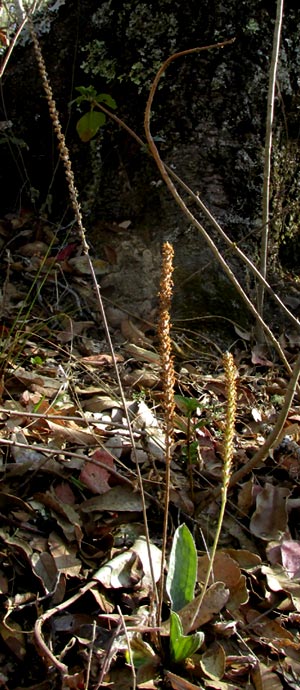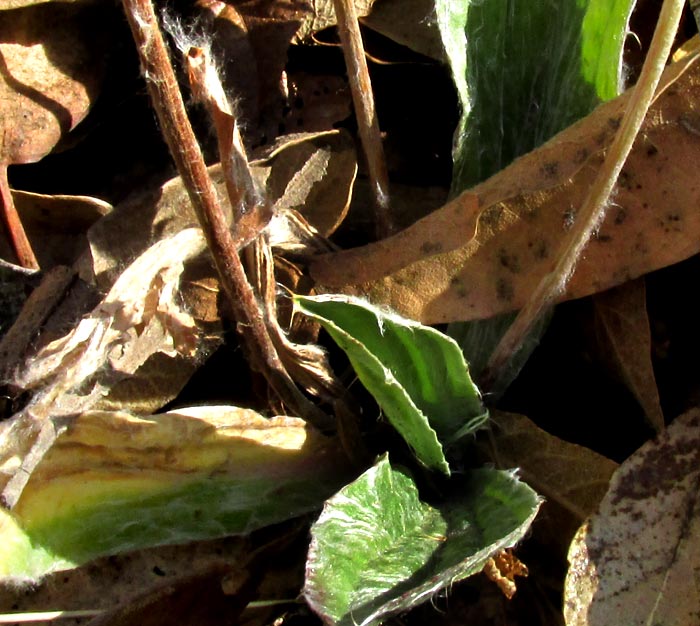Excerpts from Jim Conrad's
Naturalist Newsletter
entry from field notes dated April 16, 2022, taken in disturbed/reforesting borderline cloudforest within 1km of Valle de los Fantasmas, elevation ±2,320m (7600 ft), with limestone bedrock; about 40kms (24 miles), straight-line, ESE of San Luis Potosí, San Luis Potosí state, MÉXICO, (N22.06°, W100.62°)
FLOCCOSE PLANTAIN, OLD & NEW

Now during the late dry season, the plant at the right consists of both last season's fruiting stalks, and this season's new leaves emerging from beside the old stalks' bases. In this highland oak woods with its thick carpet of last season's crunchy leaves, just a stone's toss away I'd just encountered the Mexican Plantain, and this looked like another plantain. However, the Mexican Plantain's fruiting stalk had borne empty calyxes with no remains of the corolla or fruit, while the plant in the picture still had those things.
Moreover, when I looked closely at the fruiting stalks, this plant displayed differences from the Mexican Plantain. Below, in the shorter spike, you can see brownish, semitransparent corollas with four sharp-pointed lobes. In one flower a long, slender stigma, now dry and brittle, issues well beyond the corolla lobes. These flowers are a little beyond their prime, but still they're flowers present here at the end of dry season.

Unlike what was seen on the Mexican Plantain's flowering spike, the stem, or rachis, of this spike was heavily coated with long, cobwebby, entangling hairs. Below you can see on the middle, longer and older stalk where the ovaries have enlarged into capsular fruits, the corolla lobes have withered and curled up, and that this stalk is just as matted with long hairs as the shorther one:

This season's newly sprouted leaves at the base of the stalks bore even longer hairs than those on the stalks:

With such remarkable cobwebby hairiness, this plantain was easy to identify to species level. It's the Floccose Plantain, PLANTAGO FLOCCOSA, that word "floccose being a standard technical term for "covered with or consisting of woolly tufts." The species bears such a formal-sounding English name because the Flora of North America reports it as growing in Florida, and the Flora bestows that name on it. However, mostly the species occurs only in eastern Mexico south to Veracruz and Hidalgo states. In Mexico it's described as occurring in oak and oak-pine forests, and pastures.
The Flora del Bajío reports that sometimes the Floccose Plantain is used medicinally and as a forage plant. That sounds right, since the large, flat, relatively soft leaves of several plantain species, especially the weedy Plantago major, are mashed into a pulp (often chewed into a pulp) to make poultices for placing atop minor skin wounds, and even humans can pick leaves and immature flowering stalks of the broad-leafed plantain species, for eating raw or softly cooked.
A final word about the English word "plantain." The same word is used for the large banana tree and its banana called plantain, and the small herbaceous plants, one of which we're considering here. The two uses of the word have different histories, however. The green-herb "plantain" derives from the Old French plaintain, which came from the Latin plantago, based on the word planta, which was a nasalized form of Proto-Indo-European pleth, meaning flat, or to spread, like the sole of the foot, which has the shape, more or less, of a broad plantain leaf.
The big-banana "plantain," however, is a corruption of the Spanish word plátano, meaning banana, based on the Galibi Carib word platana, which meant banana.